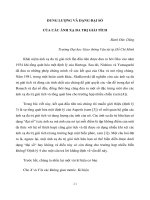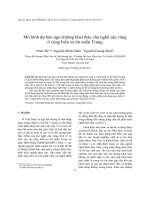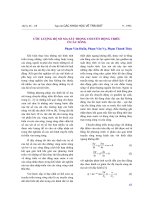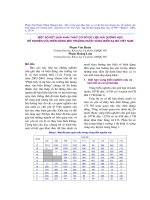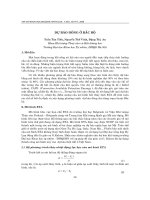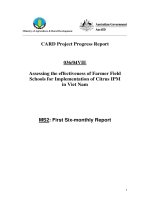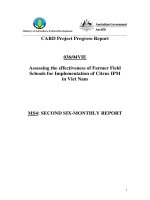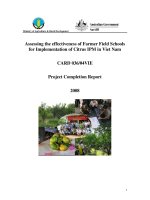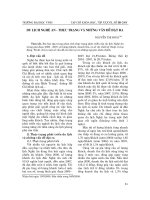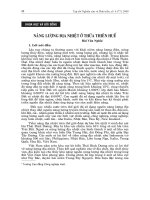Báo cáo nghiên cứu khoa học: "Dư lượng thuốc trừ sâu, biphenyl có trong sữa ở thừa thiên huế Việt Nam" pdf
Bạn đang xem bản rút gọn của tài liệu. Xem và tải ngay bản đầy đủ của tài liệu tại đây (132.34 KB, 9 trang )
393
JOURNAL OF SCIENCE, Hue University, N
0
61, 2010
ORGANOCHLORINE PESTICIDES AND POLYCHLORINATED BIPHENYLS
IN HUMAN BREAST MILK IN THE SUBURBS OF HUE CITY, VIET NAM:
PRELIMINARY RESULTS
Hoang Trong Si, Nguyen Thanh Gia
College of Medicine and Pharmacy, Hue University
Nguyen Van Hop, Thuy Chau To, Nguyen Dang Giang Chau, Le Thi Huynh Nhu
College of Sciences, Hue University
SUMMARY
The organochlorine compounds (OCs) such as organochlorine pesticides (OCPs) and
polychlorinated biphenyls (PCBs) can accumulate in breast milk through the food chain.
Human milk is a suitable bio-monitoring source to assess the burden of disease by these
compounds in humans. In this study, human breast milk samples were collected from 30
lactating mothers who were farmers, and 10 samples from lactating mothers who were not
farmers living in suburban communes of Hue city, during 2010. Questionnaires on lifestyle
factors, dietary aspects, past disease, family history, occupation, and past and current exposure
to pesticides were asked. The concentrations of OCPs as dichlorodiphenyltrichloroethane and
its metabolites (DDTs), hexachlorocyclohexane isomers (HCHs) and polychlorinated biphenyls
congeners (PCBs) were quantified by gas chromatoghraphy with micro electron capture
detector (GC-µECD). Results are reported on milk fat basis. DDTs and HCHs were detected in
all breast milk samples. PCBs were detected in some breast milk samples. There was no
significant difference in levels of OCPs and PCBs between lactating mothers who were farmers
or not farmers. The levels of DDTs, HCHs and PCBs in the breast milk samples were found to
correlate positively with the age of the mothers.
Keywords: OCs, DDTs, HCHs, PCBs, Human breast milk, Vietnam
1. Introduction
There are some plant protecting chemicals as organochlorine compounds (OCs),
two of them are DDT (diclodiphenyltricloetan) and HCH (hexacloxyclohexan). They
belong to a group of 12 persistent organic pollutants (POP
s
:), which are the most
dangerous chemicals for environmental and human health. DDT & HCH are toxic for
the nervous system and immunization system. They produce materials causing cancer
and hormone and reproductive disorders. A study from the American oncology institute
showed that OCs are a cause of the increase in rate of some types of cancer in farmers
394
such as liver cancer, spleen cancer, malignant tumours of the skin, leukemia, stomach
cancer, brain cancer, etc. Many current studies confirmed that mothers with contact or
without contact with OCs had an excess of DDT and HCH in their breast milk. DDT &
HCH are called endocrine disruptors. They are accumulated in the fatty tissue of
humans and excreted through breast milk. Their excretion is very slow. Therefore,
breast milk is used as bio- monitoring to assess the accumulation of DDT and HCH in
human. As a result of this, DDT and HCH can be estimated in breast- fed babies
Worldwide, there is much research on assessing the accumulation of OCs in the
environment, as well as the analysis and evaluation of their presence in breast milk,
with the aim of defining the origin of morbidity and fatality in humans by these
chemicals. However, there are few studies on this problem in Vietnam. This study was
conducted in some suburban communes of Hue city. Its objective is to assess the content
of OCs in breast milk.
2. Methods
2.1. Sampling
Forty mothers’ breast milk samples were taken from three suburban communes
of Hue city, Vietnam including Thuy Xuan (n=13), Huong Long (n=13) and Thuy
Duong (n = 14). The samples were selected at random. Questionnaires were given to
each mother to obtain information about their age, weight, height and occupation (table
1). The samples were stored at -20
0
C until they were analysed.
Table 1. Characteristics of the mothers participating in the study
Characteristics
Commune
Age Height (cm) Occupation
Thuy Xuan
(n = 13)
Mean
Range
26
18-35
157
147-158
Farmer 76.9%
Others 23.1%
Huong Long
(n = 13)
Mean
Range
29.4
20-38
155
152-163
Farmer 76.9%
Others 23.1%
Thuy Duong
(n = 14)
Mean
Range
28.9
19-40
157
153-167
Farmer 71.4
Others 28.6
Overall
(n = 40)
Mean
Range
28.3
18-40
156
152-167
Farmer 75.0%
Others 25.0%
395
2.2. Sample analysis
The analysis procedure was conducted using the revised methods of Minh et al
(2004) and Ulla Raab et al (2008).
Sample extraction:
Approximately 10g of breast milk samples were added onto 10 g pre-cleaned
diatomite earth (Merck, Damstadt, Germany) packed in a glass column and extracted by
200 ml diethyl ether at a flow rate of 1 ml/min. The extract was concentrated to 8 ml by
vacuum evaporator. One-fifth of the concentrated extract was used for fat content
determination by the gravimetric method. The remaining extract was purified on
chromatogaphic mini-column packed with 2g activated florisil and 1cm length of
activated anhydrous sodium sulfate top side. The lipid in the purified-extract was
removed by concentrated sulfiric acid treatment. The lipid removed extract was
evaporated to 1 ml under a gentle stream of nitrogen and was ready for gas
chromatography.
Gas chromatographic conditions:
The separation and detection of OCs was performed by the GC system (Agilent
7890 A) equipped with an auto-injection system (Agilent 7683B), micro-electron
capture detector (µ-ECD) and HP5-MS capillary column (5% phenyl methyl siloxane
phase, 30 m x 0,25 mm I.D. x 0,25 µm film thickness). Nitrogen was used as the gas
carrier at a flow rate of 1.5 ml/min and make-up gas in the detector at 5 ml/min. 1 µl of
the final extract was injected into injector operated at 285
0
C and splitless mode. The
temperature of the detector was 300
0
C. The column oven temperature was programmed
from 90
0
C (held for 2 min) to 150
0
C at a rate of 30
0
C/min, to 204
0
C (held for 3 min) at
a rate of 3
0
C/min, and finally to 280
0
C (held for 10 min) at a rate of 8
0
C/min.
2.3. Quality assurance
Multi-level calibration curves of OCs were created for quantification with good
linearity (r>0.999). Method limits of quantification (LOQ) for OCs ranged between 0.04
and 0.18 ng/ml. The recovery of method was determined based on the analysis of spiked
sample ranged between 80 and 137% for all compounds. The blanks were done in
parallel and did not show the presence of OCs on their chromatograms.
2.4. Statistical analysis
Statistical treatment of the results was performed with Excel software. The
Mann-Whitney U-test was used for comparisons of OCs level in breast milk with age,
occupation, BMI and area. A P value < 0.05 was regarded as statistically significant.
3. Results and discussion
Table 2 showed contents of OCs (DDT, HCHs and PCB) in breast milk samples
396
in some suburban communes of Hue city. Table 3 summarizes the results of published
studies on OCs in human breast milk in the world. The correlation between the content
of OCs in breast milk and age, occupation and geographical factors was presented on
table 4. Generally, DDTs and HCHs were found out in all studied milk samples while
congeners of PCBs were only seen in some milk samples. In term of correlation, there
was a relationship between the content of DDTs, HCHs and PCBs in breast milk and the
age of donors (p<0.05). However, there was no the relationship between the content of
OCs in breast milk and occupation, BMI and residence of donors (p>0.05).
Table 2. Concentration (ng/g lipid wt) of organochlorine pesticides & PCB
in human breast milk in three communes in Hue city
Thuy Xuan
(n = 13)
Huong Long
(n = 13)
Thuy Duong
(n = 14)
Overall
(n = 40)
Mean
Range Mean Range Mean
Range Mean
Range
Lipid, % 1.6 0.8 - 3.8 1.8 0.4 - 6.3
2.8 0.8 - 6.1 2.1 0.4 - 6.3
α-HCH
-HCH
-HCH
HCHs
21
22
33
76
7.0 - 34
3.5 - 68
10 - 59
21 - 149
33
25
41
99
4.2 - 104
3.0 - 103
6.1 - 107
13 - 248
16
20
23
59
4.4 - 38
4.1 - 97
6.3 - 54
27 - 189
23
22
32
78
4.2 - 104
3.0 - 103
6.1 - 107
13 - 248
p,p'-DDE
o,p' DDT
p,p' DDT
DDTs
53
7.9
29
89
2.3 - 130
1.8 - 15
0.8 - 91
4.9 - 171
43
15
48
106
5.4 - 100
2.0 - 31
7.7 - 202
18 - 284
25
11
29
65
6.3 - 68
2.3 - 18
1.3 - 86
23 - 130
40
11
35
87
2.3 - 130
2.0 - 31
0.8 - 202
18 - 284
PCB 28
PCB 52
PCB 101
PCB 118
PCB 153
PCB138
PCB 180
PCBs
<DL
65
<DL
<DL
<DL
<DL
13
78
-
<DL - 65
-
-
-
-
0.7 - 27
0.7 - 92
<DL
40
<DL
0.5
0.2
<DL
14
55
-
<DL - 70
-
<DL - 0.5
<DL - 0.2
-
1.0 - 27
1.0 - 98
1.0
24
1.2
16
1.4
0.7
19
63
< DL - 1.0
<DL - 24
<DL - 1.2
<DL - 32
<DL - 2.2
<DL - 0.8
5.3 - 48
5.3 - 109
0.3
43
0.4
5.5
0.5
0.2
15
65
<DL - 1
<DL - 65
<DL - 1.2
<DL - 32
<DL - 2.2
<DL - 0.8
0.7 - 48
0.7 - 108
DL: Detection limit of the method (PCB 28: 0.02 ppb, PCB 52: 0.05 ppb, PCB
397
101: 0.05 ppb, PCB 118: 0.11 ppb, PCB 153: 0.09 ppb, PCB 138: 0.11 ppb and PCB
180: 0.17 ppb)
Table 3. Comparison of mean concentrations (ng/g lipid) of OCPs and PCBs in breast milk
from different countries or regions.
Country Region Year
n
HCHs
DDTs
PCBs
Reference
Vietnam Hue 2010
40 78 86.9 24.2 This study
Hochiminh 2004
44 13.5 2300 14 Minh et al; 2004
Hanoi 2004
42 58 2100 74 Minh et al; 2004
Indonesia Jakarta 2001
16 14 630 33
Sudaryanto et al;
2006
Malaysia 2003
17 230 1600 80
Sudaryanto et al;
2005
Cambodia 2000
49 5.2 1500 25
Kunisue et al;
2003
The
Philippine
2000
12 4.7 190 72
Kunisue et al;
2002
China Hong Kong 1999
132 950 2870 42 Wong et al; 2002
Guangzhou 2000
54 1110 3550 33 Wong et al; 2002
Australia 1995
60 350 1200 500
Quinsey et al;
1995
USA Massachusetts
2004
38 19 65 -
Jonhson-estrepo
et al; 2007
UK
1997-
1998
168 103 470 - Harris et al;1999
Japan 1998
49 210 290 200
Konishi et al;
2001
Russia
1996-
1997
140 280 1040 380 Polder et al;2003
Sweden 1997
40 - 143 324
Noren &
Meironyte; 2000
Germany
1995-
1997
246 40 240 550
Schade and
Heinzow; 1998
398
Ukraine
1993-
1994
197 730 2700 594
Gladen et al;
1999
- Data not available
Table 4. Correlation between age, occupation, areas factors and organochlorine pesticides
concentrations in breast milk from the mothers participating in the study
Correlation coefficient (R) p-value (two-tailed)
HCHs
DDTs PCBs HCHs DDTs PCBs
Age 0.567 0.431 0.328 0.034 0.013 0.026
Occupation 0.119 0.160 0.186 0.911 0.420
0.186
BMI 0.202 0.220 0.449 0.130 0.120 0.114
Areas 0.102 0.148 0.113 0.442 0.75 0.546
* Correlation is significant at the 0.05 level (2-tailed)
3.1. HCHs
All breast milk samples contained an excess of HCH with its isomers as -HCH,
-HCH and -HCH. Among them, the average content of -HCH (32.3ng/g lipid) was
higher than that of α-HCH (23.3ng/g lipid) and -HCH (22.4ng/g lipid). The total
content of HCHs in breast milk of our study was higher than that of Nguyen Hung Minh
et al in Hanoi (with 58 ng/g lipid -HCH) and in Ho Chi Minh city (13.5 ng/g lipid -
HCH). Table 3 showed that total content of HCH in breast milk in this study was lower
than that in studies in countries such as China Japan , Malaysia , and . However, the
total content of HCHs in the study was higher than that in studies in Indonesia,
Cambodia , the Philippines and the USA .
Although HCHs use has been forbidden in Vietnam since 1993, they were
detected in biological samples and sediments in Thua Thien Hue province and other
regions in the country. . Classic research has proved that HCHs, transferred to humans
through food and water accumulated consistently in fatty tissue. Consequently, table 4
shows the relationship between the age of mothers and the contents of HCHs in their
milk.
3.2. DDTs
Like HCH, the presence of P,P'-DDE, O,P' DDT and P,P' DDT in all breast milk
samples showed that DDT has still been used in medicine and agriculture although it’s
use has been forbidden in Vietnam since 1995. The average contents of P,P'-DDE, O,P'-
DDT và P,P'-DDT and DDTs in breast milk were 40.3; 11.4; 35.2 and 86.9 ng/g lipid,
399
respectively. Among them, the content of P,P'-DDE was higher than that of O,P'-DDT
and P,P'-DDT. This result is much lower than that of Nguyen Hung Minh et al in Hanoi
and Ho Chi Minh city (the content of DDTs was 2100 and 2300ng/g lipid, respectively).
Environment and life conditions may explain for these differences. The content of DDT
and its metabolites in breast milk in the study were the same as those of Jonhson-
Restrepo et al in America (65ng/g lipid). However, they was lower than in other studies
in Cambodia (1500ng/g lipid), The Philippines (190ng/g lipid), Malaysia, (1600ng/g
lipid), Indonesia (630ng/g lipid) and developed countries such as Japan (290ng/g lipid),
Germany (240ng/g lipid), Australia (1200ng/g lipid), the UK (470ng/g lipid), Russia
(1040ng/g lipid), and the Ukraine (2700ng/g lipid) (Table 4).
3.3. PCBs
Among PCB congeners, PCB 180 was detected in all samples with its contents
ranging between 7.7- 48.3 ng/g lipid. PCB 28 did not present in any sample. PCB 52 and
PCB 101 were seen only some samples. Among them, the average contents of PCB 152
was the highest, 27.73 ng/g lipid with fluctuated interval between 5,52-56,32 ng/g lipid. The
content of PCB 52 was the lowest, 7.0 ng/g lipid. The total average content of PCBs in 40
samples was 24.2ng/g lipid. This content was similar to that of studies in some Asian
countries such as Indonesia (33ng/g lipid), Cambodia (25ng/g lipd), and China (33ng/g
lipd). However, it was much lower than in studies in high income countries such as
Australia (500ng/g lipid), Japan (200ng/g lipd), Germany (550ng/g lipid), the Ukraine
(594ng/g lipid), and Sweden (324ng/g lipid) (Table 4)
Studies have proved that high contents of HCHs, DDTs and PCBs in breast milk
may negatively affect the development of breast fed babies (Dahmardeh Behrooz et al;
2009). Medical documents indicated that HCHs, DDTs and PCBs disordered endocrine
and resisted estrogen (Annika Smeds et al., 2001; A. Polder et al., 2009). Therefore the
content of HCHs, DDTs and PCBs in breast milk is one good indicator to assess the risk
to human health. In terms of lactating mothers, the contents of OCs in breast milk is the
relationship with many factors such as age of mother, the number of their children, food,
the contents of lipids in their body and other environmental factors (Kamila
Jaraczewska et al., 2006).
4. Conclusions
All breast milk samples in the study are detected OCPs and PCBs. This is a
problem for public health in the study settings. DDTs may be a main cause of health
problems for breastfeeding mothers. Although the small sample size is not
representative for the whole population of the study setting, the results of this study are
initial and important evidence for detecting the infection of OCPs and PCBs in breast
milk in the suburbs of Hue city.
400
5. Acknowledgments
The authors would like to thank the project of Queensland University of
Technology-Vietnam for financial support for this research. The authors also wish to
thank Associate Professor Tu Binh Minh and Doctor Vo Van Thang for their technical
support.
REFERENCES
1. A. Beyer, M. Biziuk. Comparison of efficiency of different sorbents used during clean-
up of extracts for determination of polychlorinated biphenyls and pesticide residues in
low-fat food. Food Research International. 2010; 43: 831 - 837.
2. A. Polder, J. U. Skaare, E. Skjerve, K. B. Loken, M. Eggesbo. Levels of chlorine
pesticides and polychlorinated biphenyls in Norwegian breast milk (2002-2006), and
factors that may predict the level of contamination. Science of the Total Environment.
2009; 407: 4584 - 4590.
3. Agus Sudaryanto, Tatsuya Kunisue, Natsuko kajiwara, Hisato Iwata, Tussy A. Adibroto,
Phillipus Hartono, Shinsukke Tanabe. Specific accumulation of organochlorines in human
breast milk from Indonesia: Levels, distribution, accumulation kinetics and infant health
risk. Environmental Pollution. 2006; 139: 107 - 117.
4. Alvarez M. F., Lompart M., Lamas J. P., Lores M., Jares C. G., Cela R., Dagnac T.
Development of a solid - phase microextraction gas chromatography with
microelectron-capture detection method for a multiresidue analysis of pesticides in
bovine milk. Analytica Chemical Acta, 2008; 617: 35 – 50.
5. Annamalai Subramanian, Masako Ohtake, Tatsuya Kunisue, Shinsuke Tanabe. High
levels of organochlorines in mothers’ milk from Chennai (Madras) city, India,
Chemosphere. 2007; 68: 928 - 939.
6. Annika Smeds, Pekka Saukko. Identification and quantification of polychlorinated
biphenyls and some endocrine disrupting pesticides in human adipose tissue from
Finland. Chemosphere, 2001; 44: 1463 - 1471.
7. C. Campoy, M. Jimėnez, M. F Olea-Serrano, M. Moreno Frias, F. Cañabate, N. Olea, R.
Bayés, J. A. Molina-Font. Analysis of organochlorine pesticides in human milk: preliminary
results. Early Human Development. 2001; 65: 183 - 190.
8. Emma R. Burke, Alexis J. Holden, Ian C. Shaw. A method to determine residue levels of
persistent organochlorine pesticides in human milk from Indonesian women.
Chemosphere. 2003; 50: 529 - 535.
9. Gnanasekaran Devanathan, Annamalai Subramanian, Masayuki Someya, Agus
401
Sudaryanto, Tomohiko Isobe, et al. Persistent organochlorines in human breast milk
from major metropolitan cities in India, Environmental Pollution.2009; 157: 148 - 154.
10. Hiroshi Shimomura, Junya Nagayama, Shinsuke Tanabe. Contamination status of
persistent organochlorines in human breast milk from Japan: Recent levels and
temporal trend, Chemosphere. 2006; 64: 1601 - 1608.
